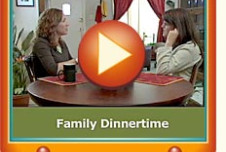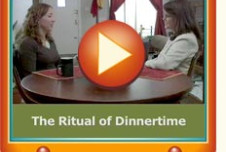Confession: Today I ate three cookies. Not because I particularly wanted them, but because they were there. I could be a case study for Brian Wansink’s book Mindless Eating: Why We Eat More Than We Think.

Wansink and his colleagues apply psychology and behavioral economics to food marketing. They use experiments to answer questions such as, “Why do we eat more than we should?” and “How do we get kids to pick healthier food in the school cafeteria?”
Here are a few of their scientifically-backed tips for making healthier food choices. Many of these tips have been put in place in lunchrooms as part of their Smarter Lunchrooms Initiative, but I think they can also be adapted for use at home, particularly if you are struggling with a child who has very particular food preferences.
1. Put the healthy food up front (and make the junk food harder to reach). People tend to take the easy route, so make the apples more available, and make them work harder for the cookies. People may also assume that the food on display is the best the restaurant/kitchen has to offer. In one study, Wansink and David Just found that moving the chocolate milk to the back of the refrigerated display, and putting the regular milk up front increased the number of students who bought regular milk.
2. Make it fun to eat healthy. Simply putting fruit into an attractive bowl, instead of a big plastic bin, increases fruit sales. Healthy may often be synonymous with boring, but you can change that pattern if you start finding fun ways to eat healthy. For example, Wansink made it fun for his daughter to eat healthy by putting walnuts in a small bubblegum machine, as you can see in this video he made:
3. Give the food a fancy name. Another way to make healthy options sound like the desirable choice is to give them a fancier name. When the bean burritos at a lunch room got renamed the “Big bad bean burrito,” they were sold out by the second lunch period. And carrots might be boring, but what preschooler can resist “X-ray Vision Carrots”? The fancy name doesn’t just work with kids; research from buffets shows that people are more likely to choose food options with fancy names. Would you choose the veggie dish? What about if there was a label in a fancy font referring to it as “Spring Vegetable Medley”?
4. Make it a choice. Carrots or celery? A simple case of psychology; giving kids a choice between healthy options lets them feel like they had a say in what they ate. Feeling like we chose our food biases us towards wanting to like it. I also think it’s harder to say “no,” when the question isn’t, “Do you want this?” but instead, “Which of these do you want?”
5. Taller is better… at least when it comes to unhealthy drinks. Have you ever compared two measuring cups in disbelief because they supposedly held the same volume but were very different shapes? Maybe that’s just me. Anyways, people perceive tall glasses to hold more liquid than short and wide glasses, so serving drinks in a tall glass will lead people to believe they drank more, making them less likely to fill up on the next round.
I’m sharing these tips because (a) I think they’re interesting, and (b) I need to learn to resist my officemate’s cookies. But as much as these tips and tricks are being used to encourage healthy eating, cunning marketers may also employ similar tactics in the hopes of getting you to make the less healthy choice. Learning to recognize and avoid these marketing tactics may be just as important as putting them to use!
Do you have other tips you’ve heard about to encourage healthy eating? Do you know other marketing tricks that companies use to get you to choose their product?







Comments
I have seen instances where companies just change the packaging, promote it as a healthy breakfast option and sell the same unhealthy food under the disguise of a healthy brand. Since we all “try to be healthy”, we fall for the simple trick.
Other times, they would simply add the word “New” to the label and we would think this is better than the old one without realizing its the same.
Third would be sponsoring some “research study” which proclaims abc is rich in xyz and so eating x quantity would enable you to lose x kilos/pounds
Praveen Kumar | 9:49 pm, June 26, 2012 | Link
1. Use a smaller plate (or cover half your serving or put it in a togo box if eating out) so your brain can start to gauge when you will be full.
2. Have the others in the house put away the chip bag when they are done, and put on a clip. You can still get them if you insist, but you won’t just happen upon them and get a craving, and you have to go through another ‘wake-up’ barrier to get them and not just eat mindlessly.
3. Finally, make a big salad and make it pretty—a work of art. Recently my son walked in the door from a three-day band trip and said, “I need a nap and a salad!” Here’s a pix of some we made: http://www.flickr.com/photos/25434820@N00/sets/72157630304757604/with/7451810828/
Denise Flora | 10:12 am, June 27, 2012 | Link